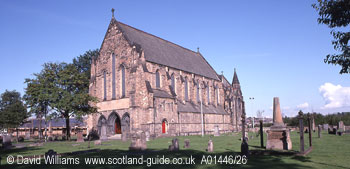1883-8, Robert Rowand Anderson
The church may not be very well known outwith Glasgow, but it is historically important because of its collection of early medieval carved stones, indicating that this is a religious site of some antiquity. Tradition has it that a monastery was started here in the sixth-century by St Constantine who came from Cornwall. Whether this is correct or not, there was certainly a thriving religious community here before the end of the first millennium which may have been dedicated to the cult of St Constantine. This was during the period in which Dumbarton was the capital of the kingdom of Strathclyde, and Govan may have been its spiritual centre and the burial place for the kingdom`s nobility. As the Middle Ages approached this would have built around it the nucleus of what later became the agricultural village of Govan which was eventually overtaken by the much-later growth of the shipyards. The first parish church here was erected around 1136 and the present building continues the religious presence on what is certainly one of the city`s most historic sites.
At first glance the church`s exterior is rather unassuming and it was certainly never finished to the architect`s plans as it lacks the planned western tower and the relief sculpture on the facade. In contrast, the church`s interior is much richer than the exterior might suggest. It is quite cavernous, with the roof`s substantial cross-members allowing a broad and uncluttered nave.
This article is based on the guidebook "The Glasgow Guide".

This late nineteenth-century church stands on a religious site dating back to the sixth century.
The church`s stained-glass windows are of exceptionally good quality and many of them are from the studio of Charles Eamer Kempe (1837-1907), an English artist whose work was predominantly for Episcopalian churches. The windows were planned as a coherent collection by Dr John Macleod (1840-98) who was minister from 1875 to his death.
The church is best-known for its remarkable collection of pre-Christian and Christian sculptured stones, probably the best such group in the whole country; they were produced in the ninth, tenth and early eleventh centuries. Equally famous are the church`s five remarkable hogback stones which were probably originally used as grave markers.
Further details about the building can be found in "The Glasgow Guide".